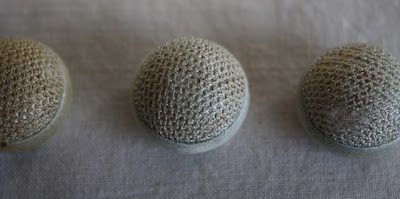Hallo my button loving darlings, today I would like to share with you a little of the story of fabric covered buttons.
The Collector's Encyclopaedia of Buttons by Sally Luscomb, defines fabric covered buttons as: "buttons covered with materials made of threads that have been woven, knitted, crocheted or joined by some other process of needlework."
 |
| Image courtesy Tauranga Historical Society |
I was told by a button collector that these buttons are Chinese, but I have found no information as yet to verify that.
Aren't they beautiful.
Fabric covered buttons were made as early as the 17th century, but descriptions are scarce and there are few extant buttons that survive.
 |
| From Fashion Kyoto Costume Institute By the 1700's buttons were elaborately embroidered, and were worn by men on coats and waistcoats. |
 |
| From Fashion Kyoto Costume Institute |
Early in the 19th century fabric covered buttons began to be made by machine, and with this change iron shells replaced wooden moulds. B. Saunders established a small factory in Birmingham, England, where he introduced a fabric covered button with a metal shank. A few years later his son invented the canvas, or flexible shank for covered buttons.
 |
| Image courtesy Tauranga Historical Society showing buttons with a flexible fabric shank |
I love this image of the Birmingham man supporting the button industry.
 |
| Image from The Collector's Encyclopaedia of Buttons by Sally Luscomb Late in the 19th century, clerks in fabric shops began to use small hand machines to cover buttons for customers. In fact shops were set up for the sole purpose of covering buttons. I wonder if there was a store in Tauranga in the 1880's, or did the Brain women have to travel to Auckland to get their buttons covered by machine. Figure 3 shows how different dies were used to make a selection of shaped buttons. |
This machine produced a flat button with a metal back.
The Defiance Button Machine Co. was a New York Company active in the 1920's that closed down in the 1980's.
 |
| Image courtesy Tauranga Historical Society |
 |
Image courtesy Tauranga Historical Society The Defiance buttons shown above were made on a machine like the one below. |
 |
| Image courtesy Tauranga Historical Society |
A selection of fabric covered buttons from the Brain Watkins House.
 |
| Image courtesy Tauranga Historical Society |
The backs of the buttons tell a little more about their construction.
 |
| Image courtesy Tauranga Historical Society |
These buttons are made over wooden moulds placing them in the late 1800's to early 1900's.
 |
| Image courtesy Tauranga Historical Society |
The backs are hand sewn with a fabric shank sewn on, to attach the button to the garment.
 |
| Image courtesy of Tauranga Historical Society |
These buttons are made of a cream silk fabric sewn over soft fibre balls. They are in poor condition with only the remnants of their embroidered decoration still remaining.
 |
| Image courtesy Tauranga Historical Society |
This set of buttons from the Brain Watkins House shows that a set of Art Nouveau styled brass buttons with brass shanks, were used as moulds to make more modern fabric covered buttons.
The advent of machine made buttons did not stop buttons being made by hand. In the 18th century hand embroidered buttons were called needlework buttons and in the mid 19th century they were referred to as dressmaker's buttons. Among these were beaded, embroidered, crocheted, and hand painted buttons, and also those made of soutache braid or laces.
This leads to another group of buttons, known as passementerie buttons, decorated with gimp, cord, beads, braid, soutache cord etc. But this is another story for another day, so bye for now.
This week I ordered some wooden button moulds from http://wmboothdraper.com/ and hope to have
some wonderful hand sewn covered buttons to show you in the future.
EXCITED!!!!!! OH YES I AM.
This week I ordered some wooden button moulds from http://wmboothdraper.com/ and hope to have
some wonderful hand sewn covered buttons to show you in the future.
EXCITED!!!!!! OH YES I AM.









What a nice selection of buttons you've chosen to show us. I can't wait to see what you come up with once your wooden button molds arrive!
ReplyDeleteThanks Jo, I am really looking forward to having a play with them.
ReplyDeletewait so are you gonna make fabric covered ones? D: Woah...
ReplyDeleteI love the first image those are so delicate and beautiful :) And that image of that guy supporting the button industry is so cool what a character!
It's a pity about how damaged some of the older ones are :(
What a funky blog I bet you had fun with this :P
I so totally did, thanks for coming on and reading it my dedicated follower.
ReplyDeleteI just went online to get some button moulds and I think Wm. Booth Draper is out of business! I can't believe this! Can someone please tell me what's up? Thanks.
ReplyDeleteSorry I do not live in Wellington, the Dreamstress does and she may be able to help,
ReplyDeletehttp://thedreamstress.com/
or
http://www.facebook.com/profile.php?id=770263705